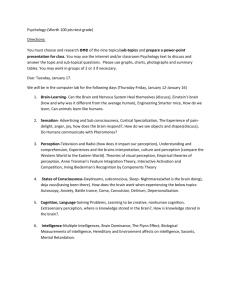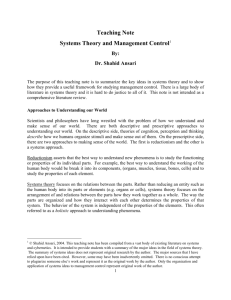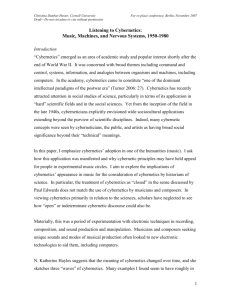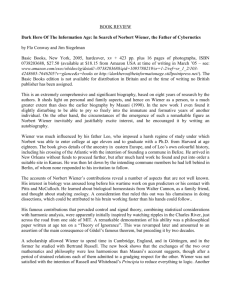Book Abstract - Orit Halpern
advertisement
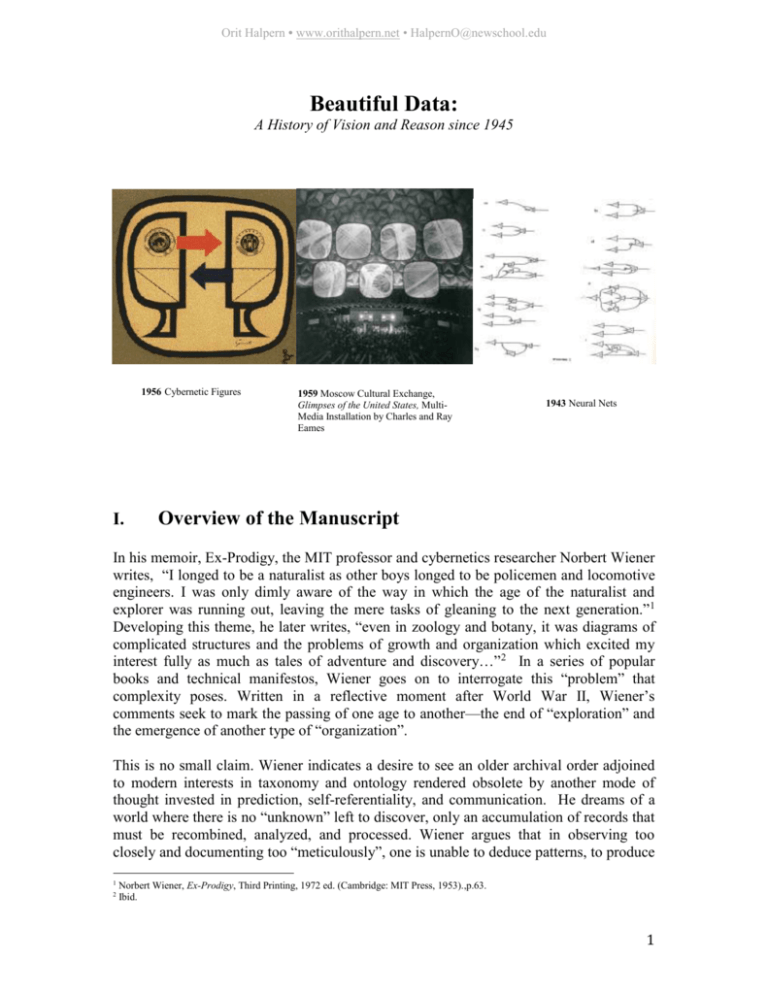
Orit Halpern • www.orithalpern.net • HalpernO@newschool.edu Beautiful Data: A History of Vision and Reason since 1945 1956 Cybernetic Figures I. 1959 Moscow Cultural Exchange, Glimpses of the United States, MultiMedia Installation by Charles and Ray Eames 1943 Neural Nets Overview of the Manuscript In his memoir, Ex-Prodigy, the MIT professor and cybernetics researcher Norbert Wiener writes, “I longed to be a naturalist as other boys longed to be policemen and locomotive engineers. I was only dimly aware of the way in which the age of the naturalist and explorer was running out, leaving the mere tasks of gleaning to the next generation.”1 Developing this theme, he later writes, “even in zoology and botany, it was diagrams of complicated structures and the problems of growth and organization which excited my interest fully as much as tales of adventure and discovery…”2 In a series of popular books and technical manifestos, Wiener goes on to interrogate this “problem” that complexity poses. Written in a reflective moment after World War II, Wiener’s comments seek to mark the passing of one age to another—the end of “exploration” and the emergence of another type of “organization”. This is no small claim. Wiener indicates a desire to see an older archival order adjoined to modern interests in taxonomy and ontology rendered obsolete by another mode of thought invested in prediction, self-referentiality, and communication. He dreams of a world where there is no “unknown” left to discover, only an accumulation of records that must be recombined, analyzed, and processed. Wiener argues that in observing too closely and documenting too “meticulously”, one is unable to deduce patterns, to produce 1 2 Norbert Wiener, Ex-Prodigy, Third Printing, 1972 ed. (Cambridge: MIT Press, 1953).,p.63. Ibid. 1 Orit Halpern • www.orithalpern.net • HalpernO@newschool.edu in his words a “flow of ideas”. He expresses a new desire—to model thought, itself, from data flows. Wiener’s memoires bridge between late 19th and early 20th century ideals of taxonomy, ontology, and archiving and post mid-20th century concepts of organization, method, and storage. He articulates a desire to see previous traditions in natural history and scientific representation replaced by a discourse of active diagrams, processes, and complexity. My book, Beautiful Data: A History of Vision and Reason since 1945, takes Weiner’s words as a point of departure to explore this historical shift in attitudes to perception, temporality, and epistemology occurring after the war. We are arguably still negotiating the legacy of this transformation. Weiner’s memories find concrete expression in such diverse places like the new multi-media architectures of spectacular geo-politics and the minute neural nets of the mind. All these locations repeat, encode, and circulate a way of looking and interpreting that can be said to constitute an architecture of both knowledge and perception. Today, seated behind our personal computer monitors, constantly logged in to data networks through our personal devices, we stare at interfaces with multiple screens and no longer aspire to go out and explore the world. There is no “unknown” left to discover. We have come to assume the world is always already fully recorded and archived; accessible at a moment’s notice through the logics of computational searches. Wiener’s words seemingly technologically realized. Our relationship to historical time, documentation, and knowledge apparently reconfigured through the terms of communication and control. In the realms of neuro-science and the many attention deficit disorders we now cultivate as pathologies this situation is ordained genetic. Humanity, it seems, always sought to communicate through screens, always wanted to garner ever more data from more locations, more immediately. It is my ambition in this book to denaturalize these assumptions. How would one, then, go about telling a history of this structure of perception and the cultural forms of the interface and storage systems upon which it rests? How would one narrate a history of our contemporary forms of interactivity and attention? Beautiful Data addresses this question methodologically, historically, and ethically. Miming Wiener’s opening refrain about a historical transformation in epistemology and ontology, Beautiful Data links histories of the archive and knowledge to genealogies of digital media. Using the post-war discourse of cybernetics—the study of communication and control—as a point of departure, this book maps contemporary obsessions with storage and interactivity in digital systems to previous modernist concerns with temporality, representation, and archiving. To map this history, the book links together scientific studies from the life and communication sciences on vision and neural nets, the work of designers and artists in marketing, propaganda, and education, philosophical writings on computing, cybernetics, and theories of mathematical communication and finally, social and human science 2 Orit Halpern • www.orithalpern.net • HalpernO@newschool.edu research on race, politics, changing urban environments, and economics. Tracing these many nodes where both subjectivities and populations were reformulated through new models iteratively produced between design, the humanities, and the social sciences and the cybernetics and communication sciences, I argue that there occurred a fundamental reorganization of knowledge, perception, and cognition—vision and reason—that is the infrastructure for contemporary discourses of interactivity, visualization, networking, and “big data”. The book traces three key themes critical to this reformulation of vision, attention, and knowledge after the Second World War: 1) Epistemology: I trace a transformation in ideals of truth and objectivity in the human and communication sciences. I document a shift in scientific practice and standards of truth from a focus on discovery, archiving, and documentation of new facts about nature to an emphasis on pattern-seeking, analysis, and recombining data. 2) Perception: I document the reconstitution of the observer, and the emergence of the idea of “interactivity” as a dominant model for human attention in psychology, design, and cognitive science. I argue that accompanying a shift in attitudes to data and information in the sciences, one can document the emergence of information intensive and multi-screen designs, the rise of communication design as a discipline and a core tool for training in engineering, urban planning, and business schools, and the emergence of the idea of the “interface” as a central design concern. These practices envisioned a new type of spectator, one simultaneously radically self-referential and environmentally networked; an observer who could scan data fields, find patterns, and constantly respond to feedback from the environment. 3) Cognition: I map the redefinition of consciousness and psychology—at both individual and organizational levels--into cognition. Psychic processes in this period came to be understood through models derived from communication theories, circuits, and computing in the human, neuro, and social sciences. This transformation in the definition of consciousness and thought developed a model of the human subject as an agent in networks intimately connected to other beings and open to the environment; offering a new set of tools for measuring, managing, and designing individual and organizational behavior in locations ranging from urban planning to marketing to politics. But I want us to turn our attention to one final element. As the opening images demonstrate, one of the central convictions of Beautiful Data is that while technologies and mediums like computers are central in re-conceiving the practices of perception and concomitant forms of representation, they are hardly determinate. As the very title of the text denotes, this is a book about histories of perception, cognition, and representation; a history of vision not a history of technology. These neural nets and multi-media architectures must be treated as “failed” projects. They are wish images. In their time, they did not produce the intended effects their designers hoped for. In this sense, these opening images and memoirs demonstrate the 3 Orit Halpern • www.orithalpern.net • HalpernO@newschool.edu desires that anticipate any technology. They are prototypes to a world that did not yet exist when they were produced. That there is any resemblance between our present and these wish-images is a matter of historical accident and choice. It is to these accidents and choices that this book is dedicated. In making a history of vision and reason an appropriate historical and philosophical object, constructed and unstable, Beautiful Data reveals the possibility that our contemporary attitudes to communication and technology may contain within them an evolutionary archive of potential paths for articulation—some that have been realized, and some that have yet to be imagined. What direction those imaginations take is at stake in how we choose to narrate the history of our digital systems and our contemporary modes of perception. II. Book Organization This history operates like the feedback loops of machines between storage, memory and interface. The book vacillates between demonstrating synchronic ideas of aesthetics and cognition at the time, and diachronically exploring how mid-20th century ideas of vision, knowledge, and recording were haunted and troubled in untimely ways by older 19th century concepts borrowed from psychoanalysis, philosophy, mathematics, and physics. The first chapter, “Archive”, is a map to the book and outlines the dominant themes of archiving, knowledge, and vision by mapping the work of Norbert Wiener and his colleagues, particularly in neuro and cognitive science at MIT, in relationship to 19th century concepts of recording, memory, and time. I track how process philosophy, psycho-analysis, pragmatism, Gibbsian physics and cinema and photography were reformulated in cybernetics to produce contemporary concepts of interactivity, storage, and information. Focusing on the cybernetic use of Bergsonism, Pragmatism, and psychoanalysis, I make a case for a contested history of time in digital media, and probe the emergent potentials of a tension between the archive and the interface that underpins contemporary desires for interaction, data storage, and data visualization. The second chapter, “Communicative Objectivity”, is about the interface, the training of the observer, and design in the 1950’s-60’s. The chapter traces the reformulation of perception, particularly vision by examining how cybernetic concepts transformed design practice and engineering, business school, and design pedagogy. Tracing the work of two designers and an urban planner--the designer and artist Gyorgy Kepes, the urban planner Kevin Lynch, and the designer Charles Eames—the chapter scales between the training of the individual observer, to a changing aesthetics of information and knowledge, and the emergence of environmental and systems approaches to management and planning. These three figures were central to American modernism, post-war design and engineering education, and urban planning, and all of them engaged with cybernetics and the communication and cognitive sciences. Their work is 4 Orit Halpern • www.orithalpern.net • HalpernO@newschool.edu landmark in creating infrastructures for post-war American life—both attentive and physical. In their respective projects we can trace the re-imaging of the observer as isolated but networked. This observer was linked to a new aesthetics of visualization and management; interactivity as a personal mode of attention and environment as a discourse for managing systems became interlaced ideals in fields ranging from marketing to urban planning. The chapter culminates with an examination of one site where practices in design, marketing, and management recombined in the 1963-64 New York World’s Fair with the innovative launch of the IBM installation “Think” advertising the new information economy, by way of an aesthetic of information inundation as a virtue, in the midst of massive urban transformations in transportation, suburbanization, economy, and race relations. The third chapter explores the doppelganger of perception in cybernetics— cognition. I examine how aesthetics and perception were linked in new assemblages to revise how, to cite IBM, we “think”. Starting with psychiatrist and cybernetician, Warren McCulloch and logician Walter Pitt’s conception of neural nets, I examine how these new ideas about mind and communication entered fields ranging from government to economics to computing. I trace the networks of interchange between cybernetic ideas of mind, and the work of political scientists, such as Harvard professor, Karl Deutsch, organizational management, finance, and artificial intelligence pioneer, Herbert Simon, and a number of other human and social scientists. These nervous networks while labeled rational were also in McCulloch’s psychiatrically informed language “psychotic”. Arguably psychotic logic became the definition of rationality and subsequently an infrastructure for data mining with implications for governance and economy. Curiously enough, having turned to psychosis and logic to redefine the behavior of subjects and systems, policy makers and social scientists turned to data visualization as a technique to compensate for what was increasingly understood to be a world of unknowns, chance, and unreasonable behavior. The remaining question is why it had been forgotten that rationality was defined in terms of psychosis, not reason, throughout the 1950’s? And what is at stake in our contemporary amnesia? While contemporary culture looks ever more frequently to neuro-science, behaviorism, and data mining to predict human behavior, economists, policy makers and even the public also continue to insist on older 19th and earlier 20th century definitions of consciousness and choice. Politics happens in this interstice between the memory of liberal reason and the embrace of psychotic logics. The fourth chapter completes the book in a feedback loop, by linking the transformations in cognition and perception with governance and rationality, to ask specifically how politics and aesthetics are linked through the valorization of 5 Orit Halpern • www.orithalpern.net • HalpernO@newschool.edu beautiful data. Examining cybernetic work on vision and cognition done by McCulloch, MIT neuro-scientist Jerome Lettvin, and psychologist George Miller in connection to the design practices of prominent American Modernist designers, George Nelson and Charles and Ray Eames, I make a case for the radical reformulation of the very tactics by which bodies, territories, and networks are governed through measurement and attention. Asking whether these aesthetic strategies encompass what we now label “biopolitics” the book ends in interrogating the ethical and political implications of making data beautiful and affective. In the final epilogue we find ourselves simultaneously inside the gardens of IBM’s corporate headquarters in suburban New York, and standing on hilltops in Jerusalem at the Israel Museum’s sculpture garden, contemplating the work of another prominent mid-century artist, Isamu Noguchi, and considering the implications of a new information aesthetics that links the inside of corporations to the reformulation of territories. This book is, therefore, a speculative endeavor in all manners by which speculate is defined—as both a matter of reflection and mediation, a matter of conjecture, and a matter of risk with possible gains and losses. And like the many speculators and corporations trying to bank in on big data and visualization, only to be frustrated in their financial ambitions, it is useful to be reminded the present is often haunted by the past and the future is often cloudy and never predictable...visualizable but not necessarily visible. 6




